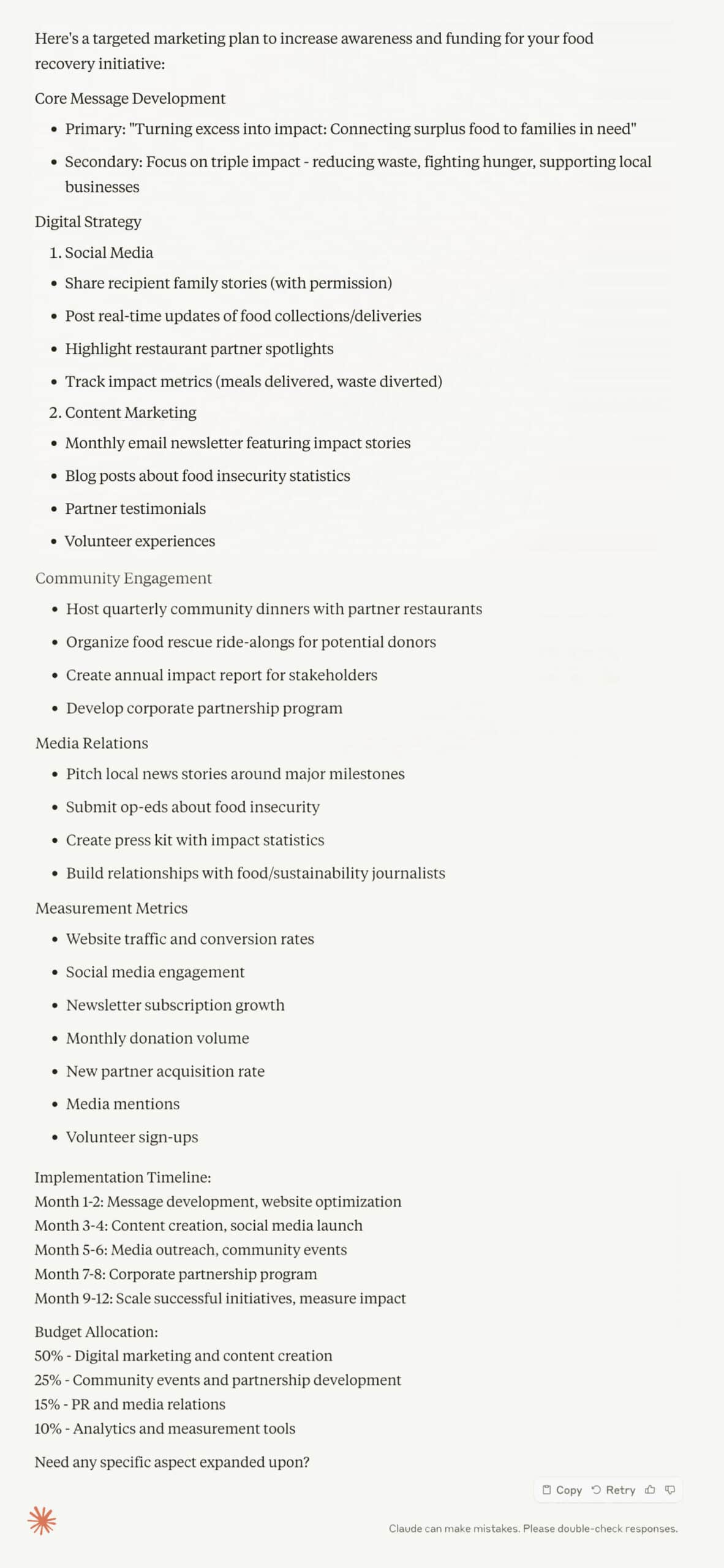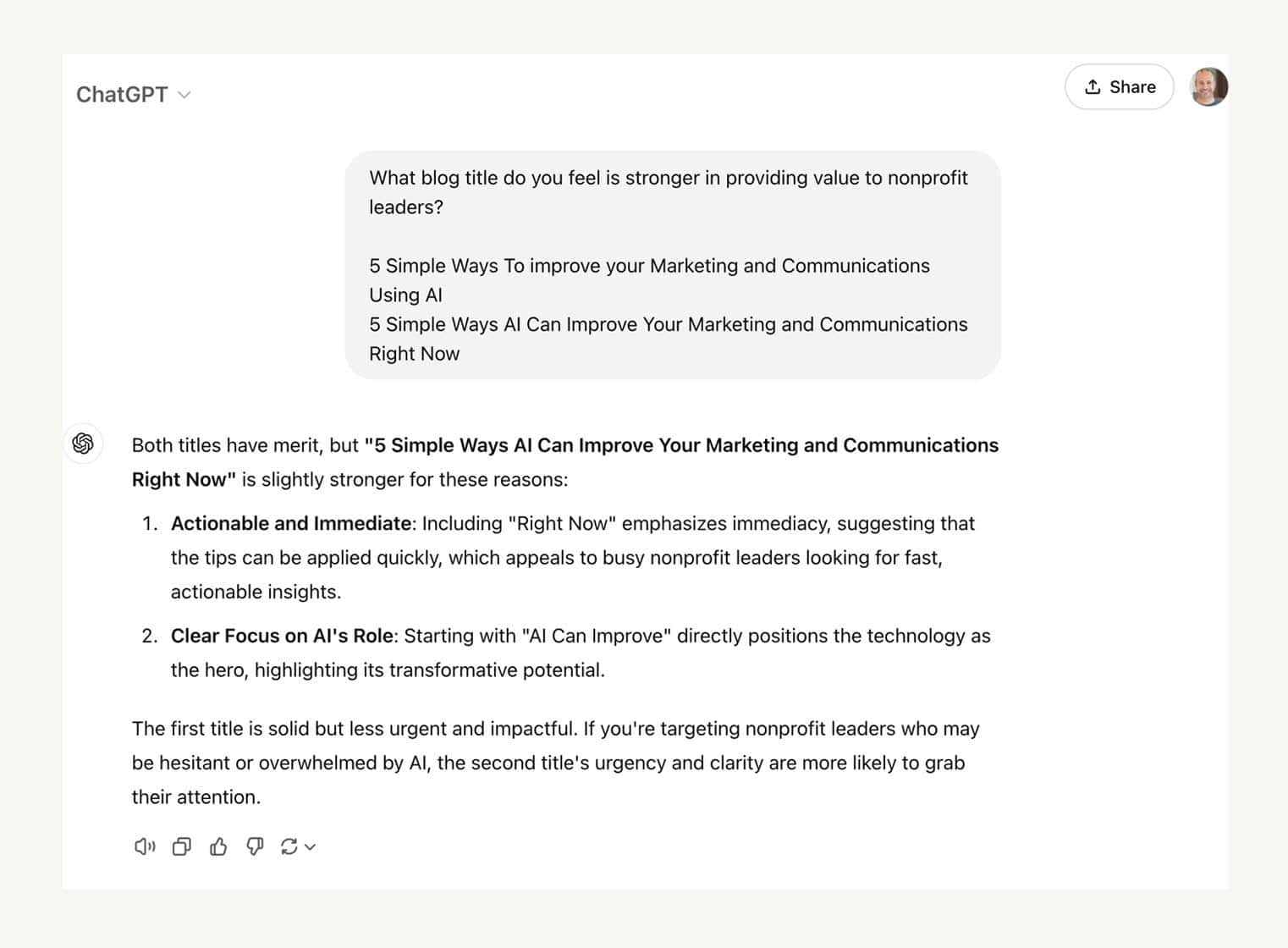December 11, 2024
5 Simple Ways AI Can Improve Your Marketing and Communications Right Now
5 Simple Ways AI Can Improve Your Marketing and Communications Right Now
Over the years, I’ve had hundreds of conversations with nonprofit leaders and fundraisers about their marketing. The number one challenge each faces is not budget, a reluctant board, or keeping up with technology. It’s capacity.
These individuals want to act on the strategy and expertise we provide, but between running their programs, meeting donors and maintaining day-to-day operations, they simply don’t have the time or staff to keep up. Enter AI.
The Ultimate Virtual Marketing Assistant
At BCS Interactive, I’m responsible for marketing our agency but – perhaps like you – I don’t have a marketing department to carry out my vision. So I’ve been working with AI tools to help me deliver more with less. And while they’re not a replacement for human authenticity, ingenuity or judgement, these products have been a game-changer in the areas of marketing support and operational efficiency.
Using AI, I’ve been able to streamline my process and produce steady marketing output in less time – and you can too. So here, out of my own playbook, are 5 simple ways to use AI to improve your marketing right now.
(Note: the products I refer to below, Claude.ai, ChatGPT are AI virtual assistants, while Perplexity.ai is an AI-powered search engine. These are just a few of my favorite tools; I encourage you after reading this post to experiment with these and others).
1. Developing a Basic Marketing Strategy
Marketing strategy is something so central to your nonprofit’s success that it’s typically left to an internal marketing team or outside experts. I still agree with that approach. So, I’m not suggesting that you entrust the entire course of your cause’s marketing to an AI bot.
Rather, AI can provide an initial marketing framework against which you can formally plan. This first step can offer inspiration, helping you see the big picture and the various tactics and options available.
How to do it in practice
Just as with human interactions, you’ll get the best results from AI tools by asking the right questions, providing context and giving detailed information towards the problem you’re hoping to solve.
To develop an example marketing plan, I used a hypothetical nonprofit that’s focused on solving food insecurity. I then typed the following into Claude.ai:

Here was the response:

Not too shabby, right? And, note the timeline and budget allocation that I didn’t even ask for.
Note that you want to start these conversations with a quality premise, and provide a specific, goal-oriented question:
Who we are: Mid-sized nonprofit
What do we do: Focused on solving food insecurity in our state
How we do it: Collecting non-perishable food and delivering to families in need
Our audience: Local restaurants, individual donors
Our goal: Grow awareness to gain donors
Question: What marketing plan would you recommend to achieve our goal in the next 3-5 years?
Once you’ve received the initial response, then the real magic happens. The AI assistant will always end with a prompt for further discussion – this is where you can refine your ask and get all of the detail and nuance you need to arrive at the outcome you want.
Here then, you have a basic marketing plan that can help you organize your future efforts, all in the span of 10 minutes.
2. Assessing your Positioning
If you’ve read my post on the 4 Steps to Growing Your Cause Online, you’ll know that the most important of the four steps is developing strong positioning.
The starting point in refining your positioning is understanding how your audience currently perceives your cause. Assessing this can be a tricky, labor-intensive process that can include audience questionnaires, internal reviews, data analysis, focus groups and more.
If you’re serious about establishing proper positioning, these tactics are part of the process, but AI can provide a positioning snapshot to help get your started.
How to do it in practice
Recently, I wanted to get a feel for how others see our own agency’s positioning. I could type “tell me about the digital agency, BCS Interactive” into Google and sure enough, a series of links would appear, starting with our website and followed by any other websites and social media channels where we’re mentioned or have a presence. But then, I’d have to look at each of these individually and piece together how I think people perceive our brand; this is both time-consuming and prone to knowledge gaps.
Instead, using Perplexity.AI, which is basically an AI-enabled search engine, I’m able to get a rough summation of how we’re seen on the web in one stroke:

This gives me a picture of our positioning drawn from multiple sources. It quickly provides one piece of the positioning puzzle, and helps me identify areas that we need to refine, restate or scrap entirely.
I encourage you to ask about your own cause in Perplexity using the prompt “tell me about, [your cause]” and see what comes up. Is the result accurate? Are you positioned in the ways you need to reach the audiences you desire? What sources is it drawing from? This is a great first step towards enhancing and improving your positioning and brand.
And, in case you’re wondering, Google is currently incorporating AI into its search functionality to achieve the same result, but they’re not quite there yet.
3. Refining Email Subject Headings
Email is an important marketing tactic, and along with segmenting your email lists by interest and providing valuable content, the key to getting people to open emails is a great subject heading. Sure, you could do this by feel, and most reputable email marketing platforms have built-in subject heading tools, but only AI currently provides you with editorial feedback around your subject headings.
For example, here’s what ChatGPT thought about my choice of subject heading for the blog you’re reading right now:

Fast, insightful – even encouraging, AI is like having a trusted writing partner by your side.
4. Researching Content for Blog Writing
In addition to the post you’re reading now, I’m writing another one that discusses the technology behind AI virtual assistants. Since I’m not an expert, I need to research how these products work, and I want to be accurate in my description.
Normally, this would take multiple hours scouring the web, then comparing what I’m learning from different websites to ensure accuracy, and then coming up with a single definition that combines the best answers from all of these sources. Not any more.
Using an AI assistant, I can provide my initial understanding of a concept and receive back a vetted and accurate summary.
How to do it in practice
Here’s an example, again using Claude.AI (but ChatGPT will work as well):


Note “Here’s how I might explain this to a novice audience” – the assistant intuits what I’m trying to achieve and explains the language accordingly.
In short, I’m able to write the supporting blog post, and when I get to an area of complexity or something I don’t understand, AI can provide a better way to describe it. I no longer have to spend hours researching and clarifying areas of my writing, but rather can focus on the main message and structure of the piece.
You can see how this may come in handy when you’re writing your own blog – or grant application, whitepaper or website content. You can write the areas that come most naturally to you, and use an AI assistant to clarify sections that can be expressed in a more direct way.
5. Improving Your LinkedIn Posts
This year, I’ve committed to posting more on LinkedIn, and I’m learning that just like every other social platform, there is a style, format and length that, according to the platform’s algorithm, will bring my posts more exposure.
I set up my initial draft in a tool called AuthoredUp, which provides a 1-10 “readability grade.” The simpler and more accessible the language in the post, the greater the potential engagement, and AuthoredUp recommends a score of less than 6 to get traction with most readers.
Once my draft is set, I’ll copy that content into either ChatGPT or Claude and ask “how can I make this even more readable?” And while I don’t take all of the assistant’s recommendations – I still want to keep my voice and original intent – I do incorporate some of the suggestions in order to achieve the score I’m looking for. I drop the edited post back into AuthoredUp, and voila – 6 or below.
This simple step has saved me hours of editing that I would normally delegate to a team member, which would take their time away from more important work.
The Era of AI is Just Beginning
The techniques I’ve described here just are just the tip of the iceberg;I haven’t even gone into what AI can do for image production or data analysis, nor the tools available for quickly developing a mock-up for a website or a sample list of pages to help you think about SEO.
While I’ve been blown away with the capabilities of these products, and I’m learning more every day, I am not advocating AI as an outright replacement for human effort and perspective. Rather, I view these as the ultimate tools for efficient work. At they end of the day, they’re called “assistants” for a reason.
So, rather than be fearful, I encourage you to lean in. You’ll work better, and because of that, your organization as a whole will thrive – and that is the ultimate goal.
TAGS:
Visiting?
Here we are.
350 Springfield Avenue #200
Summit, NJ 07901
info@bcsinteractive.com
973.377.1175
Are you ready to learn?
As a digital marketing agency for nonprofits, we write about the work and campaigns we produce, and share what we’ve learned along the way.
Count Me InSubscribe to the Blog
Sign up for monthly marketing insights you can put to use right away.
Subscribe Here